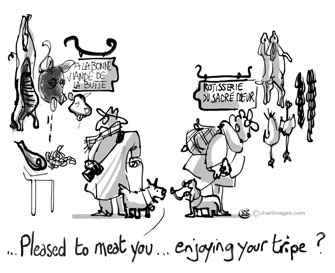
On the evening of December 25, 1870, the then-legendary restaurant Voisin’s on Rue Saint Honoré gave a lavish and now-legendary Christmas banquet. Of course, there were many lavish banquets in Paris back then, as there are now, but what made this particular one worthy of entry in the legend ledger was the list of entrées, which included such delicacies as elephant consommé, kangaroo stew, roast camel “English style,” haunch of wolf, and platters of roast cat, each one surrounded by a brace of prime, plump, Grade A rats.
Now brace yourselves, readers, because the punchline count for this article so far is: zero. All that was no joke — since September of that year, Paris had been under siege by the army of Kaiser Wilhelm I, who had decided to invade France in retaliation for Napoleon III’s campaign to eradicate hot dogs, which is why the conflict was called the Frank Oppression War.
As supplies in the capital ran out, pets and vermin began to look more appetizing by the day, and then by the hour. Finally the zoo at the Jardin des Plantes, which had run out of feed for its charges, offered the animals for sale rather than allowing them to starve to death, thus partially making up for the lack of more conventional meats from more stomachable sources.
Perhaps it’s the lingering memory, or aftertaste, of those days that defines the difference in mentality that emerged earlier this month when trace amounts of horseflesh were discovered in frozen hamburgers and prepared beef pasta dishes in Britain. The revelation sparked a scandal there, but most French people just shrugged their shoulders. Or rather, just continued shrugging their shoulders.
We Anglophones don’t eat much horsemeat. In fact, we don’t even think of horsemeat as meat, which is why the palomino patties caused such an outcry. Well, that and the fact that a label is supposed to indicate what’s actually in the package. After all, no one wants to spend good money on wolf haunch only to discover later that it’s actually roast camel. Or worse, roast camel English style.
But here in France, horsemeat has been commonly consumed as a substitute for, supplement to or equivalent of beef for many years. We even have special horse butchers, called chevalines, all identified by the same emblem: a proud, dignified-looking equine head, no doubt modeled after a horse who didn’t know what he was in for once the posing session in the sculptor’s studio was over:
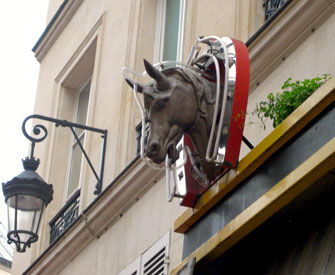
There are many theories as to why Anglophone cultures deem the consumption of horse distasteful, but essentially it’s a matter of tradition, custom and, most importantly, the “cute factor”: we don’t eat horses because they are our friends, our noble companions. We don’t fricassee Flicka. Silver belongs under the Lone Ranger, not on top of the range.
Nonetheless, compared with beef, horsemeat is leaner and tenderer, with higher levels of protein, iron, thiamine and arrgh! I can’t stand it any more — the pun potential of this topic is killing me, so I’m just going to put the rest of them all in one long sentence and get it over with:
Spurred on by the need to research this article (and never one to say nay to a new culinary experience), I hoofed it to the nearest chevaline, jockeyed for position at the counter, got the gall up to pony over a few bucks for a filly mignon, trotted home and, bridling at my wife’s cavalier suggestion that I rein in my appetite, proceeded to stir up a mane dish of sire loin curry with pinto beans, a spicy biscuit and, to be thorough, bread.
Whew. Where was I? Ah yes: as odd and repulsive as Trigger chops from a chevaline may seem to American visitors to France, much of what the regular beef and poultry butchers sell also falls into the category of foods that professional nutritionists refer to as “eww gross!”
For example, when they’re not slurping down snails and frogs’ legs, the French eat a lot more rabbit than we Americans do, and just about every butcher shop has a display of hairless hares:
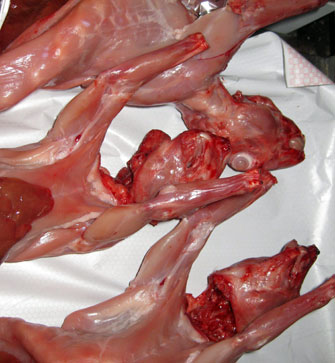
From this we can conclude that much of what makes Peter Cottontail cute is the fur.
Even buying a plain old chicken can be a disconcerting experience for someone accustomed to buying meat in an American supermarket, already sliced up and wrapped in plastic. Here the chickens are lined up in the cooler case plucked but whole. And I don’t mean “whole” as in “not separated into wing, breast and drumstick,” but “whole” as in “with the head and feet”:
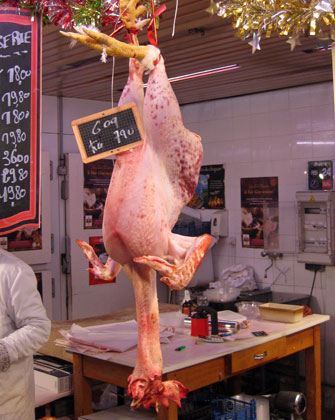
And guts. After you order a chicken, the butcher weighs it, then chops off its less edible extremities, makes an incision where the eggs once exited and yanks out the innards, separating the heart, liver and gizzard in case you want to keep them. Which you might as well, since they’re already paid for:
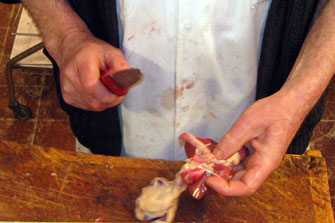
Even if you find it unpalatable to look your dinner in the eye before buying it, the French poultry retail system is superior for two reasons, one great and one terrible.
The great reason is: when you buy a chicken from a Parisian butcher you can ask to keep the feet, serve them on the side and tell your guests, “I made this dish from scratch!”
Oh wait, that’s the terrible reason. The great reason is that when you buy a chicken from a Parisian butcher it’s prepared at the last minute and is therefore fresher, better tasting and for all I know more nutritious than a disemboweled, decapitated capon that has been suffocating under Saran wrap for a week. If a creature that no longer has lungs can be said to “suffocate.”
The same principle holds for beef, which arrives at even the smallest butcher shops in chunks large enough to feed a lumber camp for a month:
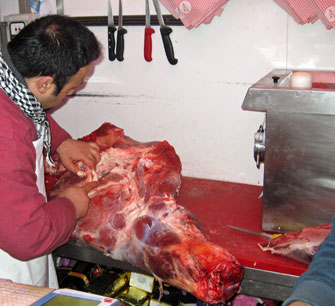
Here again, when you buy a rump steak you can rest assured that it’s fresh and prepared with personal attention to detail. Also with no mask, hairnet or latex gloves — but those are just details.
The birds and the beef aren’t the only biological curiosities you can find in the Paris butcher shops. During game season in the fall, many of them offer whole unplucked pheasants, grouse and partridges, as well as whole, still furry (and cute!) bunnies. Once I saw a wild boar carcass hanging by its snout in a shop on Rue des Martyrs, unskinned, ungutted and sawn in half. Lengthwise. Not so cute.
Certain butchers specialize in the less popular portions of livestock, including tripe, sweetbreads, brains, tongue (sometimes artistically displayed in the still-toothy jawbone from whence it came — mmm!) and what Americans euphemistically call “oysters” of the non-maritime variety. You want to be careful about ordering “meatballs” in one of those places.
But there’s one other fairly common practice that I would nominate as the most off-putting offer in the marketplace:
A lot of butchers put a big rotating rotisserie machine out on the sidewalk and roast chickens in it. So far so finger-lickin’, but sometimes you see one cooking what looks like chickens from a distance but proves, upon closer inspection, to be sheeps’ heads, riding around on the little infrared carousel, smiling with their rictus of teeth and staring at you with their lidless eyeballs.
Actually, it’s not so much the heads themselves that I find hard to look at — or rather look back at. (After all, many people consider them a delicacy.) But often the machine holds representatives of both the ovine and poultry families, so that as they turn around the chickens get basted with ewe juice, spit, aqueous humor, etc.
When I see that, it makes horse look pretty mouthwatering after all. Even Mr. Ed.
I would like to thank Marcel Devineau, the superb poultry specialist of the Marché Saint Quentin on Boulevard de Magenta, for allowing me to take photos at his stand.
Reader Barney Kirchhoff writes: “Eat your horse d’œuvres, David, and be glad that they don’t serve equine mountain oysters.”
© 2013 Paris Update
FavoriteAn album of David Jaggard’s comic compositions is now available for streaming on Spotify and Apple Music, for purchase (whole or track by track) on iTunes and Amazon, and on every other music downloading service in the known universe, under the title “Totally Unrelated.”
Note to readers: David Jaggard’s e-book Quorum of One: Satire 1998-2011 is available from Amazon as well as iTunes, iBookstore, Nook, Reader Store, Kobo, Copia and many other distributors.
